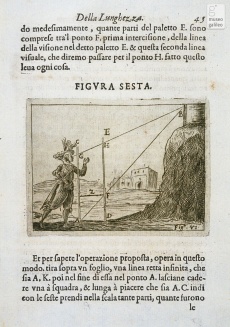Vertical Staff
From Inventions
| Line 4: | Line 4: | ||
|inventore= Thales of Miletus (7th-6th cent. B.C.)<br /> | |inventore= Thales of Miletus (7th-6th cent. B.C.)<br /> | ||
| - | + | Euclid (3rd-2nd cent. B.C.) | |
|data= 7th-6th cent. B.C. | |data= 7th-6th cent. B.C. | ||
Revision as of 10:19, 26 July 2010
Name in use since the Middle Ages (in Latin, virga).
Contents |
Inventor
Thales of Miletus (7th-6th cent. B.C.)
Euclid (3rd-2nd cent. B.C.)
Historic Period
7th-6th cent. B.C.
Description
This is probably the most ancient instrument ever used to measure unknown heights, by comparing the ratio between the verge and its shadow with the shadow cast by any vertical object, such as a tower. The tower, the verge and their shadows are in fact the cathetuses of two similar triangles having as hypotenuse the sun's ray. According to Pliny (Naturalis Historia, XXXVI, 82) the method was devised by Thales of Miletus (7th-6th C. B.C.E) but its geometric demonstration is found in Theorem XVIII of the Optics of Euclid (3rd-2nd C. B.C.E.). The sun's ray can be simulated by the visual ray that reaches the top of the tower. In this case the verge intersects a visual triangle having as base the tower, thus forming a known similar triangle. This procedure – which can also be applied in more complicated cases utilizing two measurement stations – was described already by the Indian authors Aryabhatta (no. 476) and Brahmagupta (no. 598) and in the treatise on measurement by Alhazen (965-1039). The method presumably derives from gnonomic practice (the verge is sometimes called gnomon or sciotherum) applied in antiquity not only to construct sundials but also to orient newly founded cities, buildings, and other structures such as the Egyptian pyramids (O. Neugebauer, 1983, On the Orientation of Pyramids, pp. 211-213) or the Roman land divisions (F. Blume and others, Die Schriften der Römischen Feldmesser, Hindesheim, Georg Olms Verlagsbuchhandlung, 1967, pp. 188-190). In the 15th century Francesco di Giorgio Martini proposed the use of the verge for measuring receding perspective dimensions in painting.
Bibliographical Resources
Hakim Mohammed Said, Ibn al Haitham, Proceedings of the celebrations of 1000th anniversary held under the auspices of Hamdard Natinal Foundation, Pakistan, ed. H.M. Said, Karachi, Sadar, 1970, pp. 247-254.
Martini, Francesco di Giorgio, Trattati di architettura (ca. 1480), ms., Firenze, Biblioteca Medicea Laurenziana, Cod. Ashb. 361, ed. facsimile a cura di P. Marani, Giunti, Firenze 1979, c. 32v.
Images
Author of the entry: Filippo Camerota


